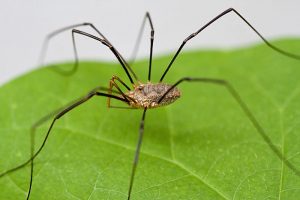While daddy longlegs are predators in their own right, they get most of their nutrients from decomposing plant and animal matter and manure.

A macro shot of a daddy longlegs on a leaf.
Photo courtesy Wikipedia
By Kate Russell

Kate Russell
We’ve all seen them in our Morgan Hill homes — spiders with tiny bodies and long, delicate legs. But those daddy longlegs aren’t spiders. The insects many of us call daddy longlegs are either cellar spiders or crane flies.
Many people say that daddy longlegs have the most potent venom of any spider and the only reason they aren’t dangerous is that their fangs are too small to bite us. Both claims are false. Daddy longlegs can bite you and their venom is too weak to hurt you.
If you see a daddy longlegs with wings, it’s a crane fly. Many people believe crane flies eat mosquitoes, but this is false. Crane fly larvae feed on the crowns, leaves, and roots of lawns and other members of the grass family, including corn and lemongrass. Crane flies are pests. If there are no wings present, it’s a spider.
The long-legged spiders most of us see are cellar spiders. Often found under loose bark and in the upper corners of rooms and garages, cellar spiders have oval- or peanut-shaped bodies.
 They can be gray, tan, or brown and often have chevron markings. Cellar spiders hang upside down from their messy, irregularly-shaped webs and will shake them when they feel threatened. These webs are not sticky, just confusing. Prey become entangled, are bitten, and then eaten or saved for later. Rather than feeding exclusively on flies or gnats, cellar spiders prefer eating other spiders. They shake the webs of neighboring spiders, tricking them into thinking prey has been trapped.
They can be gray, tan, or brown and often have chevron markings. Cellar spiders hang upside down from their messy, irregularly-shaped webs and will shake them when they feel threatened. These webs are not sticky, just confusing. Prey become entangled, are bitten, and then eaten or saved for later. Rather than feeding exclusively on flies or gnats, cellar spiders prefer eating other spiders. They shake the webs of neighboring spiders, tricking them into thinking prey has been trapped.
A fatal bite turns the host spider into the next meal. Funnel weaver spiders, hobo spiders, huntsmen, house spiders, and redback spiders (cousin to black widows) are all favorites of the cellar spider. This makes cellar spiders helpful in the house and garden, reducing the number of potentially dangerous spiders.
 Cellar spiders go by several names: carpenter spider, long daddy, marbled cellar spider, skull spider, vibrating spider, granddaddy longlegs, and daddy longlegs, hence the confusion.
Cellar spiders go by several names: carpenter spider, long daddy, marbled cellar spider, skull spider, vibrating spider, granddaddy longlegs, and daddy longlegs, hence the confusion.
Daddy longlegs have fat, fused bodies and a brown stripe on the belly. They do not build webs or produce venom but can eat chunks of food. Daddy longlegs belong to the Opiliones order. While Opiliones are arachnids, they are not spiders. Other non-spider arachnids include mites, scorpions, and ticks.
True daddy longlegs are harvestmen. They prefer hiding in moist areas, under logs and rocks, so you may find one under your kitchen sink or in a crawl space or basement.
While daddy longlegs are predators in their own right, they get most of their nutrients from decomposing plant and animal matter and manure. When they do hunt, they ambush their prey. This is impressive because their eyes cannot form images. So, crane flies are pests, cellar spiders are helpful, and true daddy longlegs are pretty much neutral.






